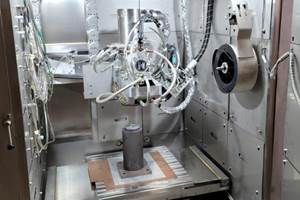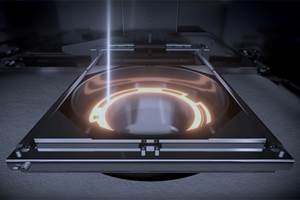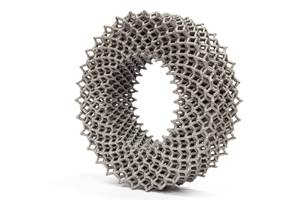Electron Beam Melting (EBM) Offers a New Alternative for Producing Titanium Parts and Prototypes
EBM promises to deliver fully dense parts with properties equal to wrought materials faster than other metal-based additive-fabrication methods.
Editor’s Note: When this article first appeared in 2006, Arcam was represented by Stratasys in the U.S. The former company has since been acquired by GE Additive.
Titanium offers a number of properties that are attractive to design engineers-high strength and low weight in addition to excellent corrosion and erosion resistance. Titanium is used in manufacturing anywhere strength and weight are an issue, such as automobile and plane parts. Completely inert to human body fluids, titanium is also ideal for medical replacement structures such as hip and knee implants. It is, however, difficult to machine, cast and weld.
Titanium Electron Beam Melting (EBM), patented by Arcam AB (Mölndal, Sweden) and distributed in the U.S. by Stratasys, Inc. (Eden Prairie, MN) offers a new method for rapid manufacturing and prototyping metal components-titanium in particular. The time, cost and challenges of machining or investment casting are eliminated, which makes titanium parts readily available for functional testing or installation. The additive process also opens the door to new design configurations and weight-reduction alternatives.
The EBM Process
In the Electron Beam Melting process, an electron beam is used to melt a titanium powder while the additive fabrication process builds parts on a layer-by-layer basis. After melting and solidifying one layer of titanium powder, the process is repeated for subsequent layers.
Within the electron beam gun, a tungsten filament incandesces and "boils off" a cloud of electrons which electrons stream through the gun at approximately half the speed of light. Two magnetic fields organize and direct the fast-moving electrons. The first field acts as a magnetic lens, which focuses the beam to the desired diameter. The second deflects the focused beam to the target point on the powder bed.
When the high-speed electrons strike the metal powder, the kinetic energy is instantly converted into thermal energy. When the temperature is above the melting point, the electron beam rapidly liquefies the titanium powder.
The electron beam gun is stationary and there are no moving mechanical parts for beam deflection. This delivers very high scanning speeds — up to 3,280 fps — and fast build rates — up to 60 cm3/hr (3.7 in.3/hr).
EBM occurs in a vacuum to prevent a loss of energy that would be caused by the fast-moving electrons colliding with air or gas molecules. The vacuum offers two advantages:
- EBM is 95 percent efficient in its use of energy — five to 10 times greater that laser technology
- The vacuum supports processing of reactive metal alloys like titanium.
Fully Dense Titanium
The EBM machine produces components from Ti6Al4V (titanium-6 percent-aluminum 4 percent Vanadium, or Ti64) and Ti6Al4V ELI, two "workhorse" alloys in manufacturing. The Ti64 parts exhibit properties that match those of wrought materials and exceed those of investment castings. The parts are 100 percent dense directly from the EBM machine, so there is no need for secondary infiltration processes. If desired, the Ti64 parts can be HIP (hot isostatic pressing) treated.
Parts produced with EBM are near-net shape like those made with metal casting processes. Since the electron beam fully melts the titanium, the liquefied metal conforms to the surrounding metal powder, which yields a surface finish similar to a precision sand casting. So, some light secondary machining or grinding may be required.
Opportunities Created
As with other additive fabrication processes, EBM has the ability to produce complex designs that are difficult or impossible to achieve when machining or casting. This freedom of design can be used to achieve true titanium parts that offer exceptional strength-to-weight ratios, decrease manufacturing costs and minimize assembly time.
Although titanium is often the best material for certain component applications, costs, challenges and time prevent its use. In these instances, machined or investment cast aluminum is used for weight reduction. When aluminum is not satisfactory, steel may be used in spite of its weight. With EBM, manufacturers have an effective alternative that combines the advantages of aluminum and steel while overcoming the obstacles of making titanium parts.
While this article has concentrated specifically on titanium, EBM has the versatility to process a wide range of metals. Arcam AB has chosen to concentrate on selected materials that most satisfy industry; however, research has been carried out on various metals. Materials such as stainless steels, aluminum, and copper alloys have been investigated and shown promise.
Another advantage is that the additive process can make a multi-piece assembly as one component. In those cases where the limits of machining and casting force a designer to create an assembly, EBM can reduce production costs. By combining two or more individual components into a single piece, assembly is eliminated, and the cost of manufacturing may be reduced. Costs are minimized using EBM through efficient recycling of the used powder. Very little powder is thrown away as waste and non-melted powder can be reused with no degradation in quality. This is good news for high-cost metal powders!
Aerospace companies, like Boeing Phantom Works, have recognized the benefits of EBM for prototyping and manufacturing. Replacing aluminum and steel parts with titanium and making a single part instead of an assembly have significant benefits to aerospace manufacturers. However, EBM offers an even greater benefit. It creates an opportunity to design and manufacture aircraft components with unprecedented strength-to-weight and buy-to-fly ratios. Besides making solid titanium parts, the additive EBM process can also produce hollow parts with an internal strengthening scaffold. Impossible with any other method, EBM can deliver the required mechanical strength with much less mass. This reduces the cost of raw materials and the weight of the component.
While the aerospace industry sees the potential of EBM, the overall build volume (200 x 200 x 180mm) limits the parts that can be manufactured. It may be impossible to please everyone but an increase in the build volume would significantly increase the use of EBM in the design of component parts.
Electron Beam Melting is a unique prototyping and manufacturing process that can simultaneously reduce costs, weight and time. It offers the material properties of machined titanium, expands the design complexity possible with casting and eliminates the challenges and time of both.
Related Content
Sciaky Develops Smaller EBAM-53 Machine for Labs, Research Facilities
With a much smaller space requirement and lower cost, the EBAM-53 features a build envelope of 26 in2, enabling test coupons, small demonstrators and geometry trial parts.
Read MoreJeol’s Electron Beam 3D Printer Meets Aerospace Qualification Standard
The company says that meeting the AMS7032 operational qualification standard ensures manufacturers that Jeol’s JAM-5200EBM is capable of producing aerospace-grade material with stable performance and meets all material specification requirements.
Read MoreWayland Additive’s Calibur3 Features NeuBeam PBF Process
Formnext 2023: The company’s fully neutralized NeuBeam process for the Calibur3 metal additive manufacturing system solves the charging issues that have previously restricted electron beam melting processes.
Read MoreJEOL Brings Electron Beam Melting and a Taste of Japan
The supplier of electron beam technology is entering the additive market with its first 3D printer.
Read MoreRead Next
3D Printing Brings Sustainability, Accessibility to Glass Manufacturing
Australian startup Maple Glass Printing has developed a process for extruding glass into artwork, lab implements and architectural elements. Along the way, the company has also found more efficient ways of recycling this material.
Read MoreLooking to Secure the Supply Chain for Castings? Don't Overlook 3D Printed Sand Cores and Molds
Concerns about casting lead times and costs have many OEMs looking to 3D print parts directly in metal. But don’t overlook the advantages of 3D printed sand cores and molds applied for conventional metal casting, says Humtown leader.
Read MoreTo Improve Performance of Compression Molded Composites, Add 3D Printed Preforms
9T Labs' Additive Fusion Technology enables the manufacture of composite structures with as much or as little reinforcement as is necessary, using 3D printed continuous fiber preforms to add strength just where needed.
Read More








.png;maxWidth=300;quality=90)













